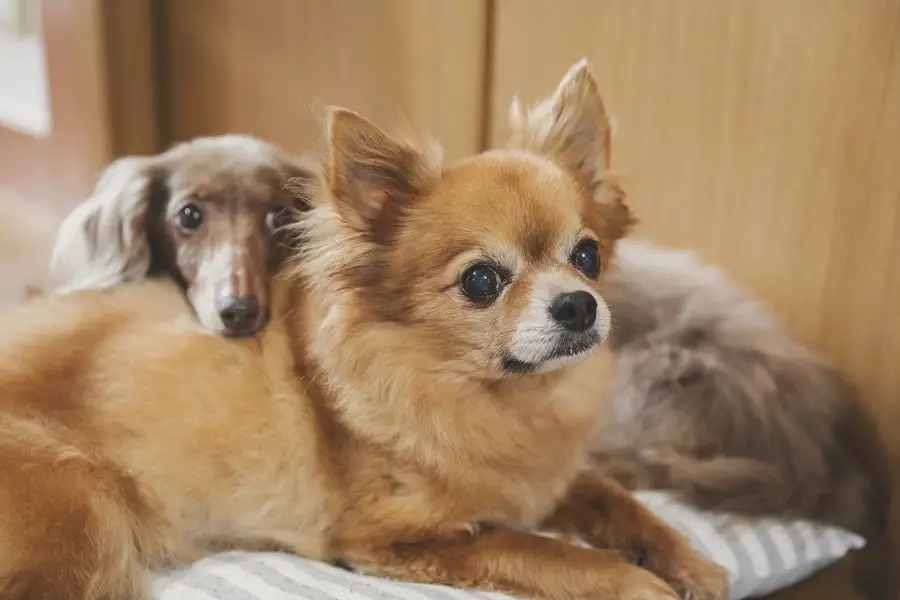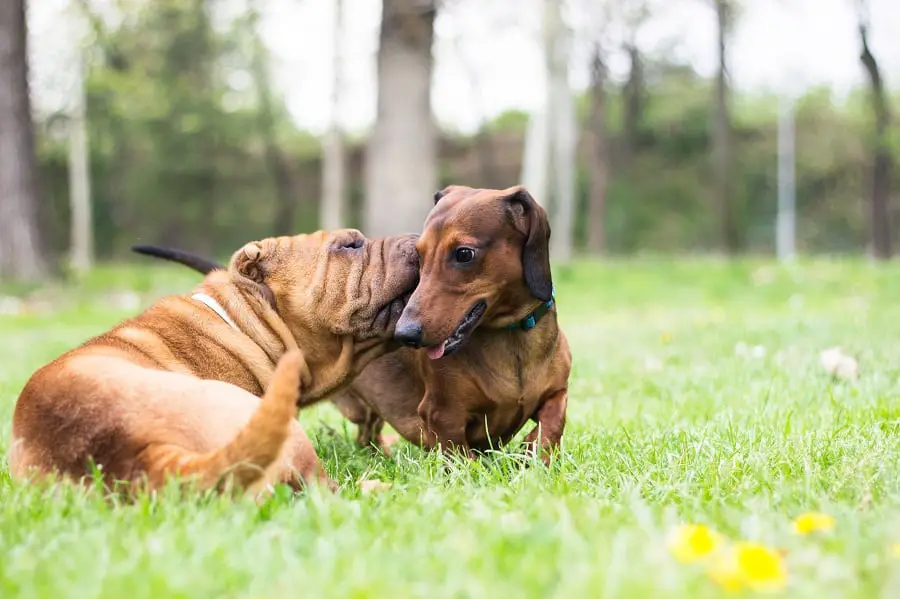If you think that the pit bull is the most aggressive dog breed, think again; that dubious honor belongs to our lovable dachshunds.
Does this mean that doxies are dangerous? Not at all.

Aggressive big dog breeds like pit bulls and Rottweilers are the most dangerous; big dogs have big bites that can cause severe injuries to humans and other dogs.
Aggressive as our little doxies may be, their small bites are just not that scary.
However, aggression can be a problem when it’s directed at other dogs in the home, or when you want to introduce a new dog to the family.
In this article, we’re going to look at the reasons for having more than one dog, how to choose a dog that will be a good fit for the resident dachshund and other dogs, and how to introduce a new dog to your home with the least amount of stress.
Does Your Doxie Really Want A Companion Dog?
Dachshunds love being with their people. If you have an only dog that gets a lot of attention, it may be wise to think carefully about your reasons for wanting another dog.
Maybe you think your doxie needs a doggie friend, or perhaps you believe that having another dog will help overcome separation anxiety.
Perhaps you just saw an adorable puppy or a sad rescue dog at the shelter, and you want to take them home with you.
These are all perfectly valid reasons for adding a second dog to the family provided that you’re realistic about the work it takes to get dogs and humans living together in peace and harmony.

The chances are that your dachshund isn’t going to immediately fall head over heels in love with a new dog joining the family.
Your doxie may get jealous and go on a search and destroy mission with your shoes, or dig up the petunias in the yard hunting down non-existent badgers.
Your dachshund’s natural aggression may make the new dog’s life a misery, or the new dog may misbehave, and your doxie forgets everything you painstakingly taught him and misbehave too.
Whatever your reason for wanting to bring another dog into your home, try to make your decision an unemotional one.
There are other ways to deal with separation anxiety and loneliness like doggy daycare and dog walkers, and if you feel sad about the rescue dog (and who doesn’t), then perhaps volunteering at the local shelter will go a long way to making both you and the rescue dogs feel better.
But it’s also true that with patience and training, adding another dog to the family can be a delightful experience for everyone.
Do Doxies Play Well with Some Breeds and Not Others?
The first thing to know is that dogs cannot tell one breed of dog from another.
Like any other dogs, dachshunds can identify that cats, rabbits, and other non-canine animals are a different species, but they don’t discriminate between different breeds of dogs.
They leave that sort of nonsense to humans. Personality is much more important than breed when choosing a new dog to join the family. Try to choose a dog that has a similar temperament to your dachshund.
Dachshunds are generally energetic and playful and will get along better with other dachshunds or dogs that have the same character traits.
Does Size Matter When Choosing a Dog to Join the Family?
Not really. There’s plenty of evidence in multi-dog families where a dachshund is the alpha dog, and the Rottweiler is the wimp.
However, a bit of caution is needed when it comes to size; a big, boisterous dog may accidentally injure a doxie if they play rough with each other.
If you want a large dog to join the family, it may be wiser to choose one of the “gentle giant” breeds like a Great Dane, Bull Mastiff, or Saint Bernard.
They may lack the energy and playfulness that your doxie would prefer in a companion, but your dachshund will be less likely to suffer an accidental injury.
Male or Female?
It’s generally believed that female dogs in the same household do not play well with each other, so if you have a female dachshund, get her a male dog companion.
On the other hand, male doxies are likely to get along with both female and male dogs.
Does Age Matter?

If the reason you’re getting another dog is so that your doxie has a companion, then age does matter. An older dachshund may find a boisterous puppy irritating.
It’s also likely that older and younger dogs have different energy levels and may not be the best companions.
It’s better to get a companion dog close in age to your dachshund.
Have a Trial Run Before Deciding on Another dog
There are exceptions to every rule; lazy dogs may play well with active ones, females may get along just fine with each other, and old and young dogs may form a special bond.
The only way to know for sure if a new dog is a good fit for your doxie is to have a tryout and let the dogs decide.
But before you do that, there are good and bad ways to introduce dogs to each other, as well as some preparations to be made.
Tips on How to Introduce a New Dog to The Family
Whether you’re bringing in a second dog as a companion to your doxie, or whether you’re adding a dog to a multi-dog family, following some simple suggestions will make everyone’s life easier.
As always, remember that you’re the alpha dog and that the pack will react to how you behave. If you’re excited, they’ll be excited. If you’re calm, they’re more likely to be calm too.
Before you bring the new dog home, close off a section of the house with baby gates or barriers. Put the new dog’s food and water bowls, bed and toys in the enclosed area.
Before bringing the new dog into the house, put the resident pets in a closed-off separate room.
Walk the new dog on a lead around the rest of the house so that he gets used to the smell of the dogs already living there.
The dogs should be introduced to each other one at a time and always on leads. Ask a family member or friend to help you.
Bring one resident dog out at a time and let the two dogs get near each other but far enough apart to easily pull them away from each other if either one shows signs of aggression.
If either or both dogs start growling and snarling, or their body movements are stiff and slow, and the hair on their back is standing up, lead them away from each other.
Try again at a further distance apart until both dogs are relaxed. Praise both dogs when they get close enough to sniff each other without any signs of aggression. This first meeting is the most crucial part of introducing dogs to each other.
Depending on how many resident dogs you already have, it could take quite a lot of time and patience to get them all comfortable and relaxed with each other.
When the dogs reach the stage of being calm around each other, put the new dog in the enclosed section that you previously prepared, and let the resident dogs roam the house freely as they’ve been used to.
Experts suggest that the dogs should be separated like this for a few days. Take the new dog out of his area on a lead a few times every day to meet and greet the resident dogs.

There shouldn’t be any growling and snarling at this stage but if there is, put the new dog back into his enclosure and try again later.
After a few days the dogs should be quite familiar with each other, and you can let the new dog mingle with the other dogs under your close supervision.
Separate them for a few minutes at the first sign of aggression, like growling and snarling, and then let them mingle and play again. Give each dog lots of individual attention and praise them when they play well together.
You can remove the barriers from the dog’s enclosure but leave his possessions in the same area until he decides for himself that he’s willing to eat and sleep with the other dogs.
What Not to Do
Contrary to what some people believe, new and resident dogs will not “sort themselves out” by forcing them into the same area and “letting them get on with it.”
This is an irresponsible way to introduce dogs to each other and can lead to injury.
Also, if you introduce dogs to each other this way and they’re aggressive with each other without being checked, it’s highly unlikely that the dogs will ever get along and your house will be in a state of constant tension and squabbling.
Much better to take it slow and easy for a peaceful and harmonious home in the long term.
Playmates
Even our surprisingly aggressive doxies will love having one or more doggie playmates if you choose the right companion and take a little time to introduce them to each other properly.
